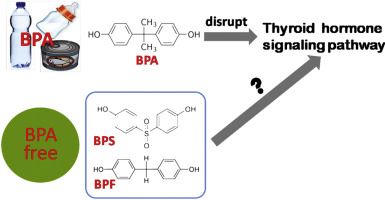Environmental Pollution ( IF 7.6 ) Pub Date : 2017-11-13 , DOI: 10.1016/j.envpol.2017.11.027 Yin-Feng Zhang , Xiao-Min Ren , Yuan-Yuan Li , Xiao-Fang Yao , Chuan-Hai Li , Zhan-Fen Qin , Liang-Hong Guo

|
The wide use of the alternatives to bisphenol A (BPA) has raised concerns about their potential toxicities. Considering the disrupting activity of BPA on thyroid hormone (TH) signaling, we investigated whether bisphenol S (BPS) and bisphenol F (BPF), two leading alternatives, could interfere with TH signaling pathway using a series of assays in vitro and in vivo. In the fluorescence competitive binding assay, we found BPS and BPF, like BPA, bound to TH receptors (TRα and TRβ), with the binding potencies an order of magnitude lower than BPA (BPA > BPF > BPS). Molecular docking data also show their binding potencies to TRs. In the coactivator recruitment assay, BPS and BPF recruited coactivator to TRβ but not TRα, with weaker potencies than BPA. Correspondingly, agonistic actions of the three bisphenols in the absence or presence of T3 were observed in the TR-mediated reporter gene transcription assay. Also, all the three bisphenols induced TH-dependent GH3 cell proliferation, whereas BPA and BPF inhibited T3 induction in the presence of T3. As for in vivo assay, the three bisphenols like T3 induced TH-response gene transcription in Pelophylax nigromaculatus tadpoles, but in the presence of T3 altered T3-induced gene transcription in a biphasic concentration-response manner. These results for the first time demonstrate that BPS and BPF, like BPA, have potential to interfere with TH signaling pathway, i.e., they generally activate TH signaling in the absence of T3, but in the presence of TH, display agonistic or/and antagonistic actions under certain condition. Our study highlights the potential risks of BPS and BPF as BPA alternatives.
中文翻译:

双酚A替代双酚S和双酚F干扰甲状腺激素信号传导途径在体外和体内
双酚A(BPA)替代品的广泛使用引起了人们对其潜在毒性的担忧。考虑到BPA对甲状腺激素(TH)信号的破坏活性,我们使用一系列体外和体内试验研究了两种主要替代品双酚S(BPS)和双酚F(BPF)是否会干扰TH信号通路。。在荧光竞争结合测定中,我们发现BPS和BPF像BPA一样,与TH受体(TRα和TRβ)结合,结合力比BPA低一个数量级(BPA> BPF> BPS)。分子对接数据还显示了它们与TR的结合力。在共激活剂募集试验中,BPS和BPF将共激活剂募集到TRβ而不是TRα,其效力比BPA弱。相应地,在TR介导的报道基因转录测定中观察到在不存在或存在T3的情况下三种双酚的激动作用。同样,所有三种双酚均诱导TH依赖性GH3细胞增殖,而BPA和BPF在存在T3时抑制T3诱导。至于体内测定,三种双酚(如T3)诱导了TH反应基因的转录。Pelophylax nigromaculatus t,但在T3的存在下以双相浓度响应方式改变了T3诱导的基因转录。这些结果首次证明BPS和BPF像BPA一样,有可能干扰TH信号传导途径,即它们通常在不存在T3的情况下激活TH信号传导,但在存在TH的情况下表现出激动或拮抗作用在一定条件下的动作。我们的研究强调了BPS和BPF作为BPA替代品的潜在风险。









































 京公网安备 11010802027423号
京公网安备 11010802027423号